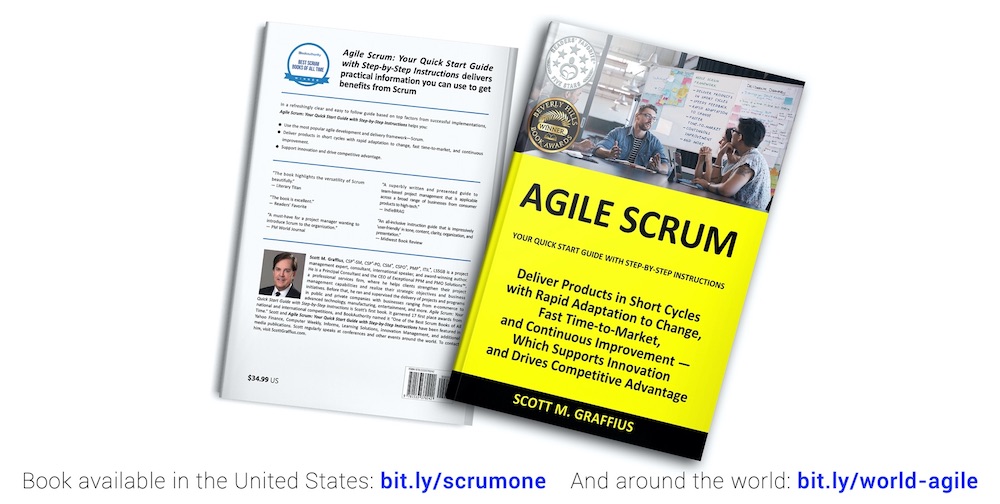The Story Behind “Agile Scrum: Your Quick Start Guide with Step-by-Step Instructions” - Agile Transformation at an Entertainment Company | Part 7
11 April 2019


Agile Workflows

The Story Behind Agile Scrum: Your Quick Start Guide with Step-by-Step Instructions — Agile Transformation at an Entertainment Company
Scott M. Graffius, CEO of Exceptional PPM and PMO Solutions™, helps companies achieve their strategic objectives and business initiatives through project management leadership. A fantastic agile transformation outcome with a client organization in the entertainment industry was the inspiration for Scott's award-winning book, Agile Scrum: Your Quick Start Guide with Step-by-Step Instructions. This is the story behind the book—told by Scott. Identifying details have been changed and certain elements are not included.
This article is the seventh installment of the eight-part story. If you haven't already read the earlier parts, you can find them here:
- Part 1: The Call;
- Part 2: The Goals;
- Part 3: The Environment;
- Part 4: The Options;
- Part 5: The Pilot – Vision, Roadmap and Release Plan, and Product Backlog; and
- Part 6: The Pilot – Sprint Planning and Sprint Execution.

Part 7: The Pilot – Sprint Review and Sprint Retrospective
The Scrum team—Product Owner, Scrum Master, and the Development Team—and I discussed techniques for the sprint review. The event is sometimes referred to as the sprint demo. The timebox (not to exceed duration) in hours for the meeting was calculated as:
- 1
- multiplied by the number of weeks in the upcoming sprint (2 in this case),
- which equaled 2 hours for the event.
Participants included the Product Owner, Scrum Master, Development Team, and stakeholders. All of the stakeholders (the executives mentioned in earlier parts of the story) were invited to and attended the sprint review. At the session, the Product Owner welcomed attendees and communicated the agenda. He pointed out the sprint goal, which was displayed on the wall in the meeting room. Next, the Development Team listed the work that was committed to the sprint. They then listed the work that was completed and the work that was not completed. For each completed story/feature, the Development Team demonstrated the "done" working functionality and answered questions. Stakeholders were invited to interact with the "done" working functionality and they did so. Then the entire group reviewed the product backlog and collaborated on what to do next. The Product Owner incorporated feedback into the Product Backlog. It involved adding new items to the backlog and/or re-prioritizing existing items. After the sprint review, the Scrum Master incorporated any feedback related to problems into the impediments backlog.
The Scrum Master and I discussed techniques for the sprint retrospective event. The timebox in hours for the meeting was calculated as:
- 0.75
- multiplied by the number of weeks in the upcoming sprint (2 in this case),
- which equaled 1.50 hours for the event.
At the sprint retrospective, the Development Team identified what went well, what didn't go well, and improvements to be implemented in the upcoming sprint—an example of inspection and adaptation. For improvements to be implemented, each member of the Development Team wrote their top one, two or three suggestions on sticky notes. Each idea got its own sticky note. Then the Development Team grouped the sticky notes into categories/themes, and they discussed the items and voted to determine the top one (initially limited to one, later it was raised to two) for adaptation and improvement. The Development Team committed to the change and the Scrum Master recorded the information.
The Story Behind Agile Scrum: Your Quick Start Guide with Step-by-Step Instructions — Agile Transformation at an Entertainment Company concludes with Part 8: The Success.

About Agile Scrum: Your Quick Start Guide with Step-by-Step Instructions

Shifting customer needs are common in today's marketplace. Businesses must be adaptive and responsive to change while delivering an exceptional customer experience to be competitive.
There are a variety of frameworks supporting the development of products and services, and most approaches fall into one of two broad categories: traditional or agile. Traditional practices such as waterfall engage sequential development, while agile involves iterative and incremental deliverables. Organizations are increasingly embracing agile to manage projects, and best meet their business needs of rapid response to change, fast delivery speed, and more.
With clear and easy to follow step-by-step instructions, Scott M. Graffius's award-winning Agile Scrum: Your Quick Start Guide with Step-by-Step Instructions helps the reader:
- Implement and use the most popular agile framework―Scrum;
- Deliver products in short cycles with rapid adaptation to change, fast time-to-market, and continuous improvement; and
- Support innovation and drive competitive advantage.
Hailed by Literary Titan as “the book highlights the versatility of Scrum beautifully.”
Winner of 17 first place awards.
Agile Scrum: Your Quick Start Guide with Step-by-Step Instructions is available in paperback and ebook/Kindle worldwide. Some links by country follow.
- 🇦🇺 Australia
- 🇦🇹 Austria
- 🇧🇪 Belgium
- 🇧🇷 Brazil
- 🇨🇦 Canada
- 🇨🇿 Czech Republic
- 🇩🇰 Denmark
- 🇫🇮 Finland
- 🇫🇷 France
- 🇩🇪 Germany
- 🇬🇷 Greece
- 🇭🇺 Hungary
- 🇮🇳 India
- 🇮🇪 Ireland
- 🇮🇱 Israel
- 🇮🇹 Italy
- 🇯🇵 Japan
- 🇱🇺 Luxembourg
- 🇲🇽 Mexico
- 🇳🇱 Netherlands
- 🇳🇿 New Zealand
- 🇳🇴 Norway
- 🇪🇸 Spain
- 🇸🇪 Sweden
- 🇨🇭 Switzerland
- 🇦🇪 UAE
- 🇬🇧 United Kingdom
- 🇺🇸 United States
- 🌏 More countries

Let's Connect

Connect with AgileScrumGuide.com on Facebook, Twitter, LinkedIn, Instagram, and Pinterest.
And connect with agile project management practitioner, consultant, award-winning author, and international speaker Scott M. Graffius on Twitter, Facebook, and LinkedIn.

© Copyright 2019 Scott M. Graffius, AgileScrumGuide.com. All rights reserved. This material may not be published, broadcast, rewritten or redistributed without the express written permission of Scott M. Graffius/AgileScrumGuide.com.
